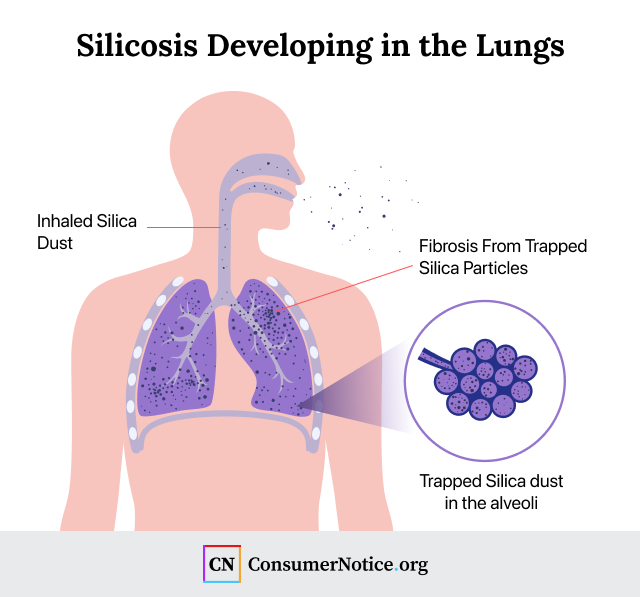Silica Dust
Silica is a mineral found in many common products. Fine silica dust can penetrate deep into the lungs. Prolonged silica dust exposure can contribute to serious health complications, including COPD, emphysema, lung cancer and silicosis.

What Is Silica Dust?
Silica dust contains fine particles that form during mechanical alteration to silica-containing materials, such as concrete, bricks, tiles, quartz and other stones. There are two types of silica: amorphous and crystalline. Medical experts and health officials have identified the dust from crystalline silica as hazardous. It is a known human carcinogen and is also associated with several serious health conditions.
A few reports suggest that amorphous silica can cause respiratory diseases (but not silicosis) in workers. Studies in lab animals suggest that although breathing amorphous silica can cause lung inflammation and injury, it is less hazardous than crystalline silica.
- Silica is one of the most abundant naturally occurring minerals in the world.
- Amorphous and crystalline are the two types of silica.
- Dust produced by mechanical action on silica-containing materials is a known health hazard.
Quartz is the most common form of respirable crystalline silica. It is in numerous everyday products, including art clays and glazes, caulk, cleansers, cosmetics, paint, pet litter and talcum powder. When inhaled, dust particles settle deep in the lungs. This can contribute to elevated rates of lung cancer, particularly among individuals with consistent occupational or environmental exposure to silica dust.
Silica Dust Exposure Risks
Occupational exposure is the greatest risk factor for silica dust-related health conditions. Workers in certain industries face a greater risk of silica dust exposure than others. For example, because cutting or sanding common construction materials produces silica dust, bricklayers, stone masons and construction workers are at increased risk of exposure. Workers in oil and gas extraction, mining and countertop fabrication and installation may also inhale large qualities of silica dust daily.
There is also a risk of secondary exposure to potentially harmful silica dust. Workers who bring the minute particles home on clothing and gear may inadvertently spread them throughout the home. Family members and friends who breathe in these particles may develop complications from silica dust exposure.

Occupational and environmental exposure to silica dust is a known risk in several common occupations. According to the U.S. Department of Labor, approximately 2.3 million people face regular workplace exposure to the mineral. Employers must take steps to reduce silica dust exposure. Occupational Safety and Health Administration regulations outline proper precautions.
What Products Contain Silica Dust?
Silica is a mineral that forms within the Earth’s crust that is used to manufacture commonly used products such as clay, granite, glass and concrete. It appears as silicon dioxide in numerous natural materials, with quartz and feldspar being the most significant silica-containing minerals.
- Bricks
- Ceramics
- Clay
- Cleansers and other skin care products
- Concrete
- Construction materials
- Glass
- Granite
- Plaster
- Quartz
- Rocks
- Sand
- Soil
- Talcum powder
Because of its ubiquitous nature, most people have some level of silica dust exposure in the natural course of daily life. However, these levels are rarely harmful. Repeated exposure over years, such as in occupations involving constructing with silica material or manufacturing secondary products with silicon dioxide, can lead to overexposure.
Mining, refining and manufacturing processes often release crystalline silica dust. Excessive exposure to second-hand dust, such as through dust shed from work clothing, may pose health risks.
Silica-Related Diseases
Silica dust exposure may contribute to several serious, debilitating and life-altering health conditions. Lung cancer and silicosis are among the more severe conditions caused by silica dust.
- Autoimmune disorders
- Bronchitis
- Cardiovascular impairment
- Chronic obstructive pulmonary disease
- Emphysema
- Kidney disease
- Lung cancer
- Silicosis
Pulmonary silicosis is a debilitating condition that causes the formation of silicotic nodules in the lungs. These lesions tend to group in the upper lobes. They can lead to impaired lung function and eventually death. Silica dust exposure is the only cause of silicosis.
How Much Silica Dust Is Harmful?
No clear answer exists on how much silica dust is harmful; however, experts typically do not consider it dangerous in small amounts. Repeated occupational exposure and consistent secondary exposure pose the greatest health risks.
Medical experts generally agree that limiting silica dust exposure is the most effective method for preventing related illnesses. OSHA-established limits for maximum exposure levels provide guidelines for the general public.
Regulations and Ways to Protect Yourself From Silica Dust
Both OSHA and the Mine Safety and Health Administration maintain guidelines and oversee regulations designed to limit silica dust exposure. These include air concentration limits for silica dust and training, safety equipment, monitoring and reporting requirements.
OSHA has issued guidelines for general industry and maritime operations and the construction industry. These established permissible limits for airborne crystalline silica exposure as well as best practices for maintaining those limits. MSHA regulations establish exposure limits, controls for drills and air sampling requirements.
- MSHA Permissible Exposure Limits for Respirable Quartz
- National Institute for Occupational Safety and Health Recommended Exposure Limits
- Occupational Exposure to Respirable Crystalline Silica 29 C.F.R. § 1926.1153
- Occupational Exposure to Respirable Crystalline Silica 29 C.F.R. § 1910.1053
In general, requirements of OSHA regulations mandate the establishment of a written exposure control plan, the designation of someone to implement that plan and restrictions on practices that expose workers to silica dust. Additionally, employers must offer medical exams every three years for certain at-risk workers, train workers on ways to limit silica dust exposure and maintain records of silica exposure and medical exams.
Failure to follow safety guidelines can result in excessive exposure to silica dust, increasing the risk of developing serious health complications. Individuals exposed to silica dust or who worked under unsafe conditions and later developed silicosis may be able to take legal action against product manufacturers or employers. Anyone diagnosed in the past five years with a related health condition, such as silicosis, fibrosis, lung cancer or systemic lupus erythematosus, who also has a history of silica dust exposure, should speak to an attorney to discuss a silicosis lawsuit.
11 Cited Research Articles
Consumernotice.org adheres to the highest ethical standards for content production and references only credible sources of information, including government reports, interviews with experts, highly regarded nonprofit organizations, peer-reviewed journals, court records and academic organizations. You can learn more about our dedication to relevance, accuracy and transparency by reading our editorial policy.
- NIOSH. (2023, July 11). Silica. Retrieved from: https://www.cdc.gov/niosh/topics/silica/default.html
- State of California Department of Industrial Relations. (2023). What are the Possible Exposure Sources? Hazards of Silica in Construction. Retrieved from: https://www.dir.ca.gov/dosh/etools/08-019/sources.htm
- IOSH. (2023). All about silica dust. Retrieved from: https://iosh.com/health-and-safety-professionals/improve-your-knowledge/no-time-to-lose/all-about-silica-dust/
- National Cancer Institute. (2022, December 5). Crystalline Silica. Retrieved from: https://www.cancer.gov/about-cancer/causes-prevention/risk/substances/crystalline-silica
- National Toxicology Program. (2021). Silica, Crystalline (Respirable Size), Report on Carcinogens, Fifteenth Edition. Retrieved from: https://ntp.niehs.nih.gov/sites/default/files/ntp/roc/content/profiles/silica.pdf
- ATSDR. (2020, January 14). ToxFAQs for Silica. Retrieved from: https://wwwn.cdc.gov/Tsp/ToxFAQs/ToxFAQsDetails.aspx?faqid=1492&toxid=290
- OSHA. (2019, May 14). Safety and Health Regulations for Construction. Retrieved from: https://www.osha.gov/laws-regs/regulations/standardnumber/1926/1926.1153
- CDC. (2004). Silicosis: Learn the Facts! Retrieved from: https://www.cdc.gov/niosh/docs/2004-108/pdfs/2004-108.pdf?id=10.26616/NIOSHPUB2004108
- Merget, R. et al. (2001, November 29). Health hazards due to the inhalation of amorphous silica. Retrieved from https://link.springer.com/article/10.1007/s002040100266
- OSHA. (n.d.). Silica, Crystalline. Retrieved from: https://www.osha.gov/silica-crystalline
- OSHA. (n.d.). Small Entity Compliance Guide for the Respirable Crystalline Silica Standard for General Industry and Maritime. Retrieved from: https://www.osha.gov/sites/default/files/publications/OSHA3911.pdf
Calling this number connects you with a Consumer Notice, LLC representative. We will direct you to one of our trusted legal partners for a free case review.
Consumer Notice, LLC's trusted legal partners support the organization's mission to keep people safe from dangerous drugs and medical devices. For more information, visit our partners page.
855-842-1699

